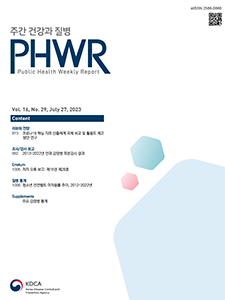Current Issue
Vol.16 No.29, July 27, 2023
-
Review & Perspective 2023-07-27
 0
0
 2830
2830
 405
405
Comparing International Computing Systems of COVID-19 Core Indicators and Measures to Improve Usability
Naae Lee, Yeon-gyeong Kim, Seungpil Jung, Woojoo Lee, Juhwan Oh, Seung-sik Hwang
Public Health Weekly Report 2023; 16(29): 973-991 https://doi.org/10.56786/PHWR.2023.16.29.1 Abstract
AbstractFor effective pandemic control of coronavirus disease 2019 (COVID-19), production and management of relevant indicators to predict and analyze epidemic patterns, development and evaluation of dashboards that visually represent data have not yet been achieved. In this study, we utilized medical quality assessment methods to review key COVID-19 prevention indicators and evaluated both domestic and international dashboards in terms of usability. Most countries provide major prevention indicators focusing on COVID-19 incidence and hospital bed-related indicators. In Republic of Korea (ROK), a significant number of management indicators are also provided, but there is a shortage of publicly available indicators for specific targets and time periods. Therefore, it is necessary to develop indicators that encompass various infection and socio-economic vulnerability factors and to develop estimation models that can reflect the characteristics of infection in ROK through policy development and the utilization of these indicators. Interactive dashboards are the most useful in the COVID-19 pandemic situation. The interactive dashboards enable data management and processing, provide information to users at their view point, and implement appropriate visual elements. In addition, dashboard improvements that consider the use of clear indicators, easy accessibility, and information placement readability are needed.
-
Surveillance Reports 2023-07-27
 0
0
 490
490
 191
191
Ophthalmologic Sentinel Surveillance Results, 2013–2022
Yejin Seo, Inho Kim, Jeongok Cha, Seulki Kang, Jin Gwack*
Public Health Weekly Report 2023; 16(29): 992-1004 https://doi.org/10.56786/PHWR.2023.16.29.2 Abstract
AbstractKorea Disease Control and Prevention Agency has been operating an Ophthalmologic Sentinel Surveillance System since August 2003 to monitor the epidemic of epidemic keratoconjunctivitis ( EKC) and acute hemorrhagic conjunctivitis (AHC), both of which are highly contagious eye diseases. From 36 weeks in 2013 to 53 weeks in 2022, the surveillance results showed a significant decrease in the average annual number of suspected cases of EKC, from 22.5 cases per 1,000 outpatients in 2018 to 4.0 in 2022. In particular, EKC showed a seasonal increase during the summer, peaking in August and September. Despite a significant decrease in suspected cases from 2020 to 2022, the seasonal epidemic pattern remained similar to previous years. Furthermore, the peak rate has decreased each year since 2016 (49.7 cases), but increased again in 2022 (9.0 cases). Contrastingly, suspected cases of AHC remained consistently low compared to EKC, without any seasonal epidemic pattern. Both diseases were most reported in the age group 0–6 years, with a significant decrease observed in all age groups after 2020, maintaining lower levels compared to pre-coronavirus disease 2019 (COVID-19) years. This decline is likely attributed to the implementation of COVID-19 control measures such as social distancing. However, as COVID-19-related measures have been gradually lifted, it is anticipated that the occurrence will gradually increase to pre-pandemic levels, emphasizing the importance of continuous monitoring.
-
QuickStats 2023-07-27
 0
0
 1049
1049
 173
173
Trends in the Prevalence of Seat Belts Non-Users among Adolescents, 2012–2022
Public Health Weekly Report 2023; 16(29): 1006-1007 https://doi.org/10.56786/PHWR.2023.16.29.4

pp. 1433~1461
Most Keyword
?
What is Most Keyword?
- It is the most frequently used keyword in articles in this journal for the past two years.
Most Read
-
Waterborne and Foodborne Disease Outbreaks in the Republic of Korea, 2023
Myung-Jae Hwang, So Yeon Park, Hyungjun Kim, Se Jeong Yang, Sungchan Yang, Jin Seon Yang
Public Health Weekly Report 2025;18: 17-32 https://doi.org/10.56786/PHWR.2025.18.1.2 -
Implementation Plan for the Coronavirus Disease 2019 Vaccination for the 2024–2025 Season: Recommendations of the 6th Expert Committee on Immunization Practices
Hyewook Hwang, Wookeon Lee, Seohyeon Ahn, Young-Sook Choi, Seunghyun Lewis Kwon, Dongwoo Lee, Eun Hwa Choi, SokGoo Lee
Public Health Weekly Report 2025;18: 90-102 https://doi.org/10.56786/PHWR.2025.18.2.3
Editorial Office
+82-43-719-7569





 Full Text
Full Text Cite
Cite


